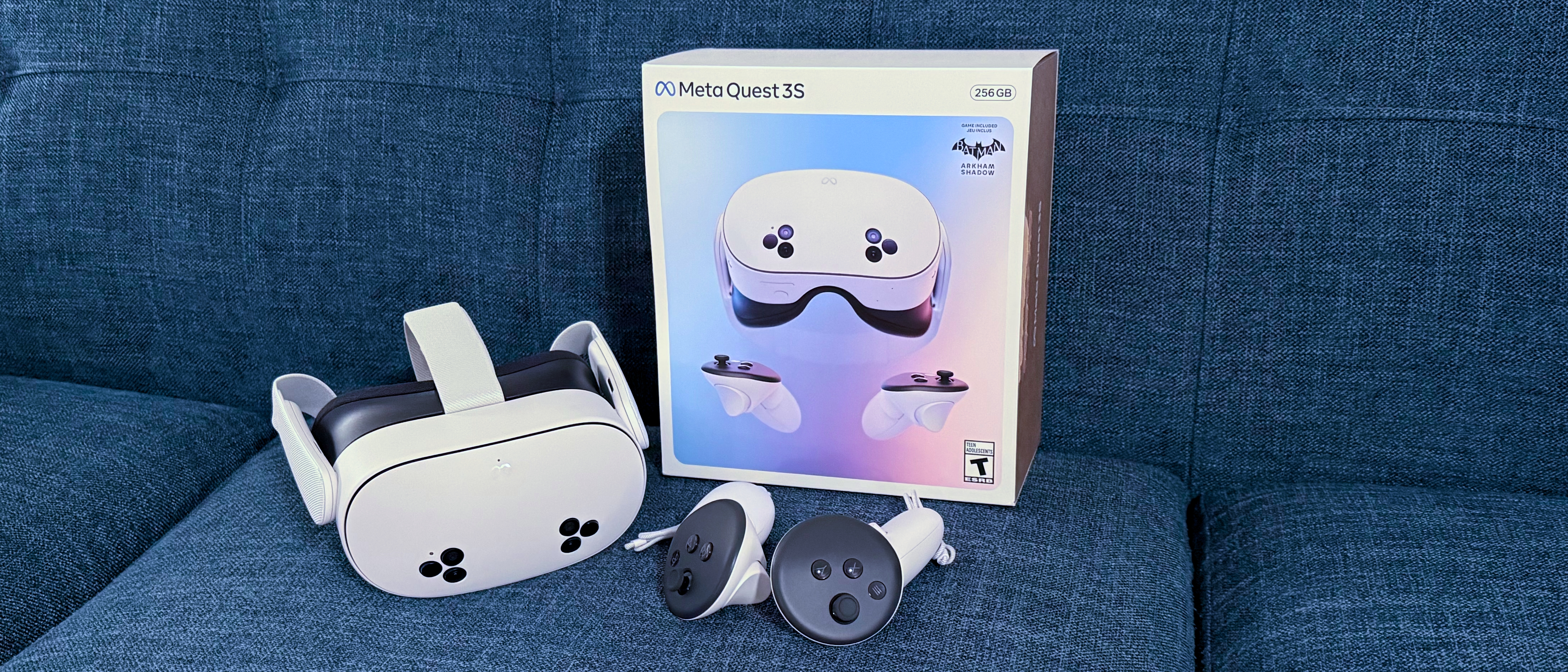Tom's Hardware Verdict
Meta has a winner on its hands with the Quest 3S from a value and performance perspective.
Pros
- +
$200 lower starting price compared to the Quest 3
- +
Slightly better battery life than the Quest 3
- +
Same CPU, RAM, and base storage as Quest 3
- +
Batman: Arkham Shadow is included with purchase
Cons
- -
Lower-resolution displays lead to a grainer picture
- -
Narrower interpupillary distance range
Why you can trust Tom's Hardware
A little over a year ago, I reviewed the Meta Quest 3, a well-intentioned iterative upgrade to the Quest 2 that came before it. The Quest 3 enhanced the mixed reality experience with higher resolution displays and a faster Qualcomm Snapdragon XR2 Gen 2 processor. This year, Meta released the Quest 3S, which brings over many of the superlatives of the Quest 3, with a few notable downgrades.
By dialing things back a bit on the spec sheet, Meta offers the Quest 3S at just $299, which is $200 cheaper than the launch price of the Quest 3. While the price reduction furthers Meta’s dream of putting mixed reality headsets into the hands of more people, read on to see if the company strikes the right balance between features and performance for the average consumer.
Design of the Meta Quest 3S
The Quest 3S doesn't stray too far from the Quest 3 with its exterior design. You still get a beefy headset constructed of high-quality white plastic. The most significant difference between the two headsets is visible from the front -- the Quest 3 houses most of its exterior cameras/sensors within three vertical pill-shaped pods at the lower center of the exterior faceplate. The Quest 3S has two groupings of three sensors on the lower faceplate.
Looking at the Quest 3S from the front, you'll find the power button and a USB-C port for charging on the right side. On the bottom left are volume controls and a new action button. The action button allows you to switch between passthrough and immersive modes.
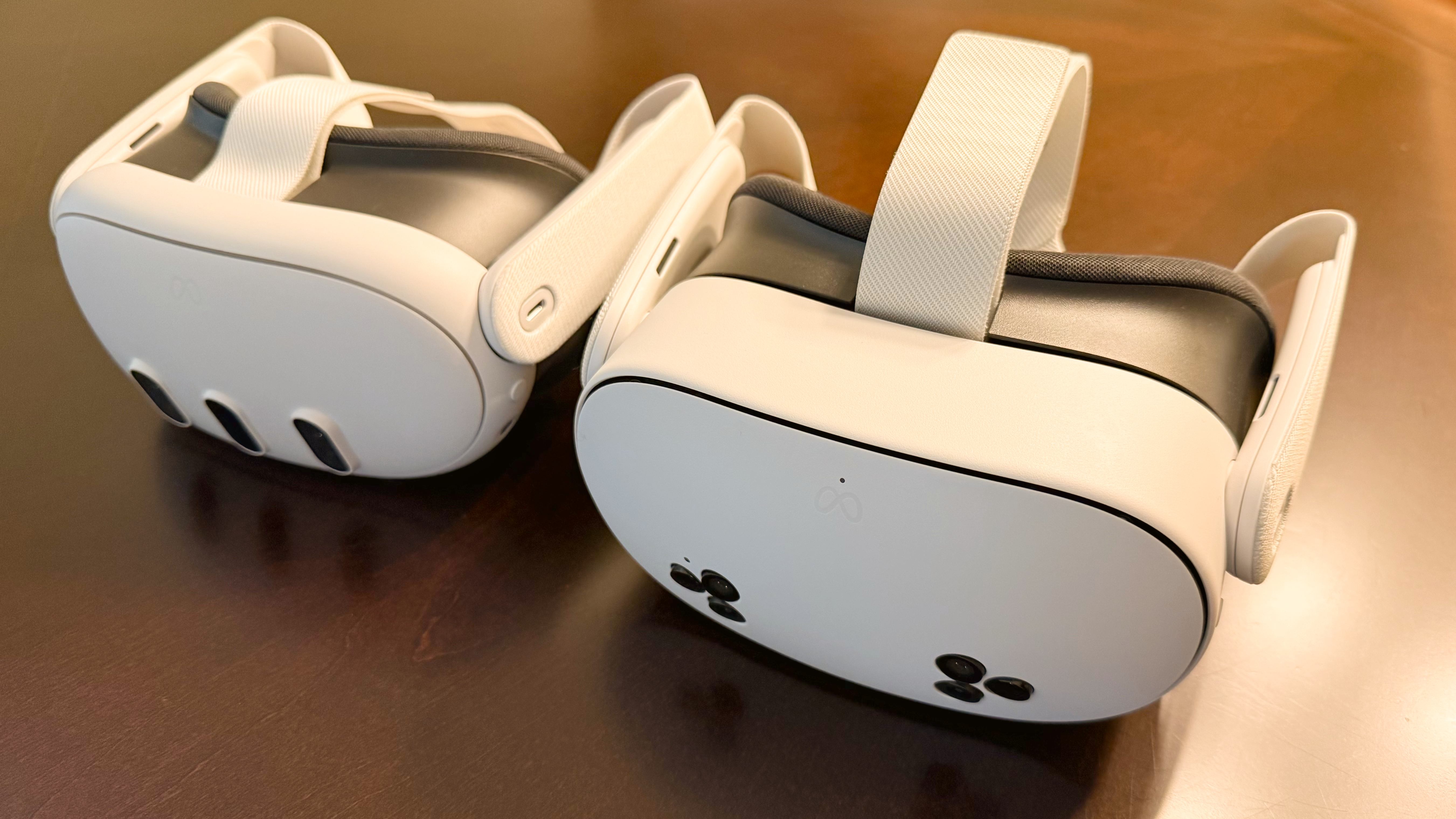
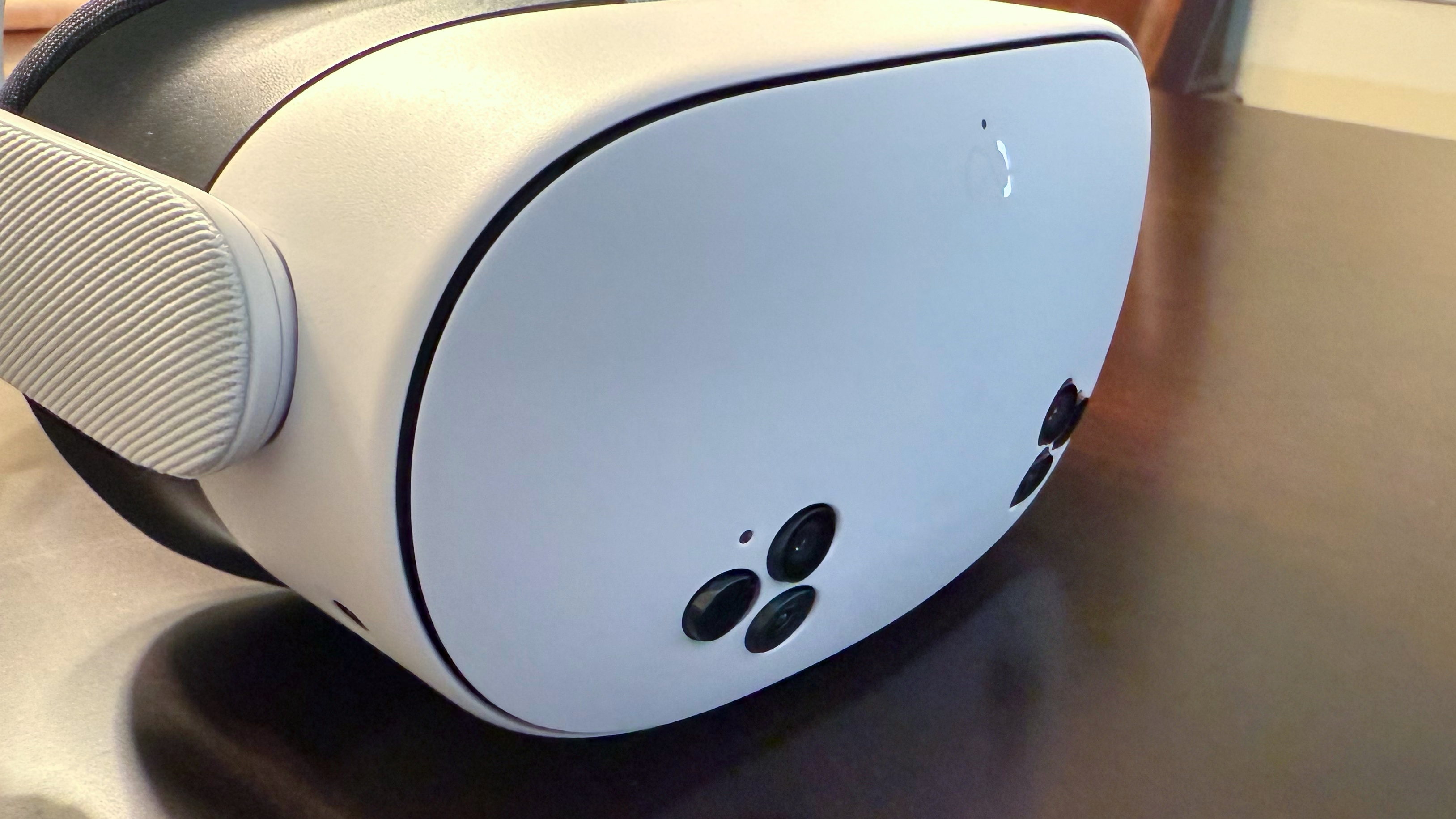
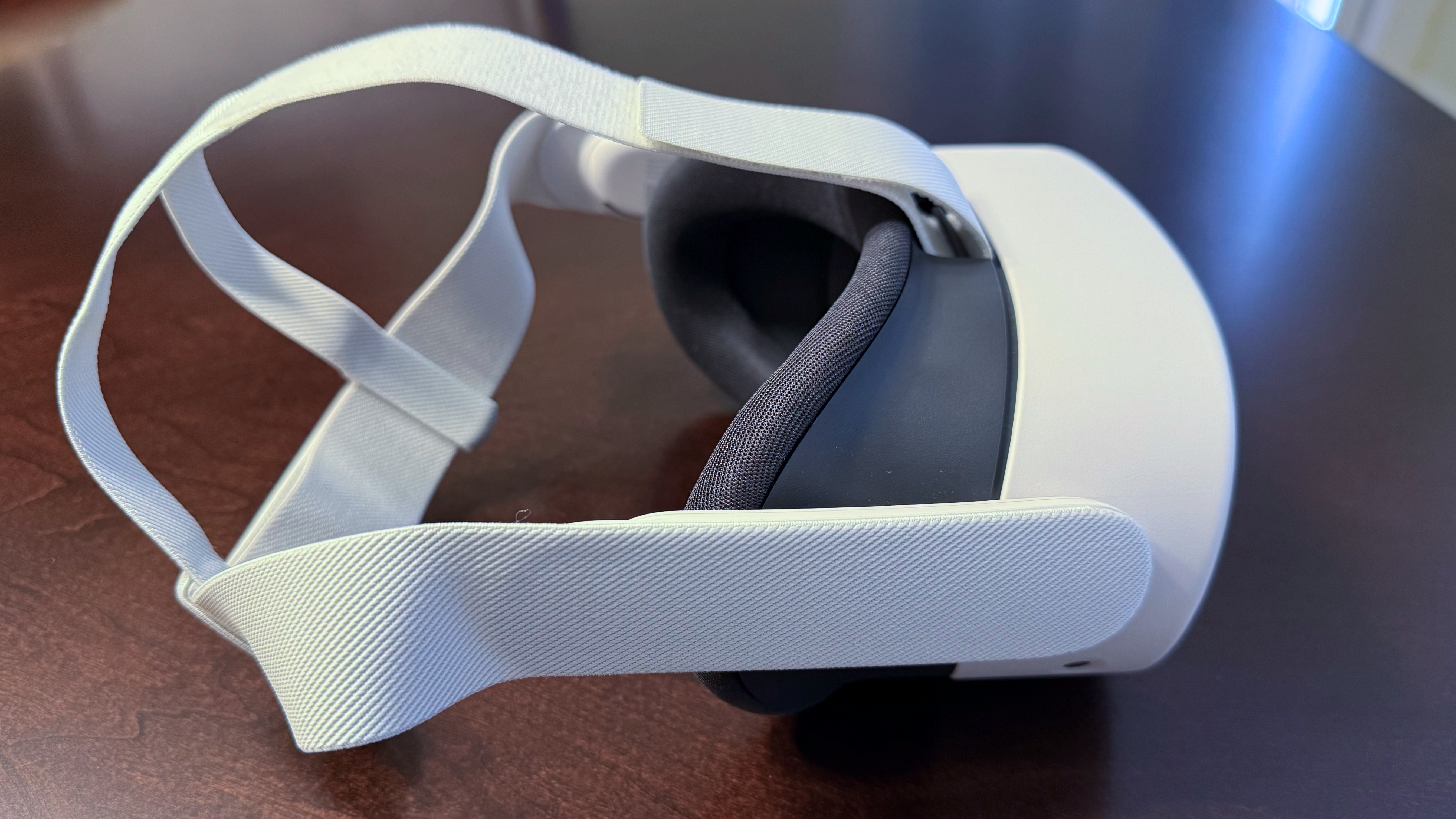
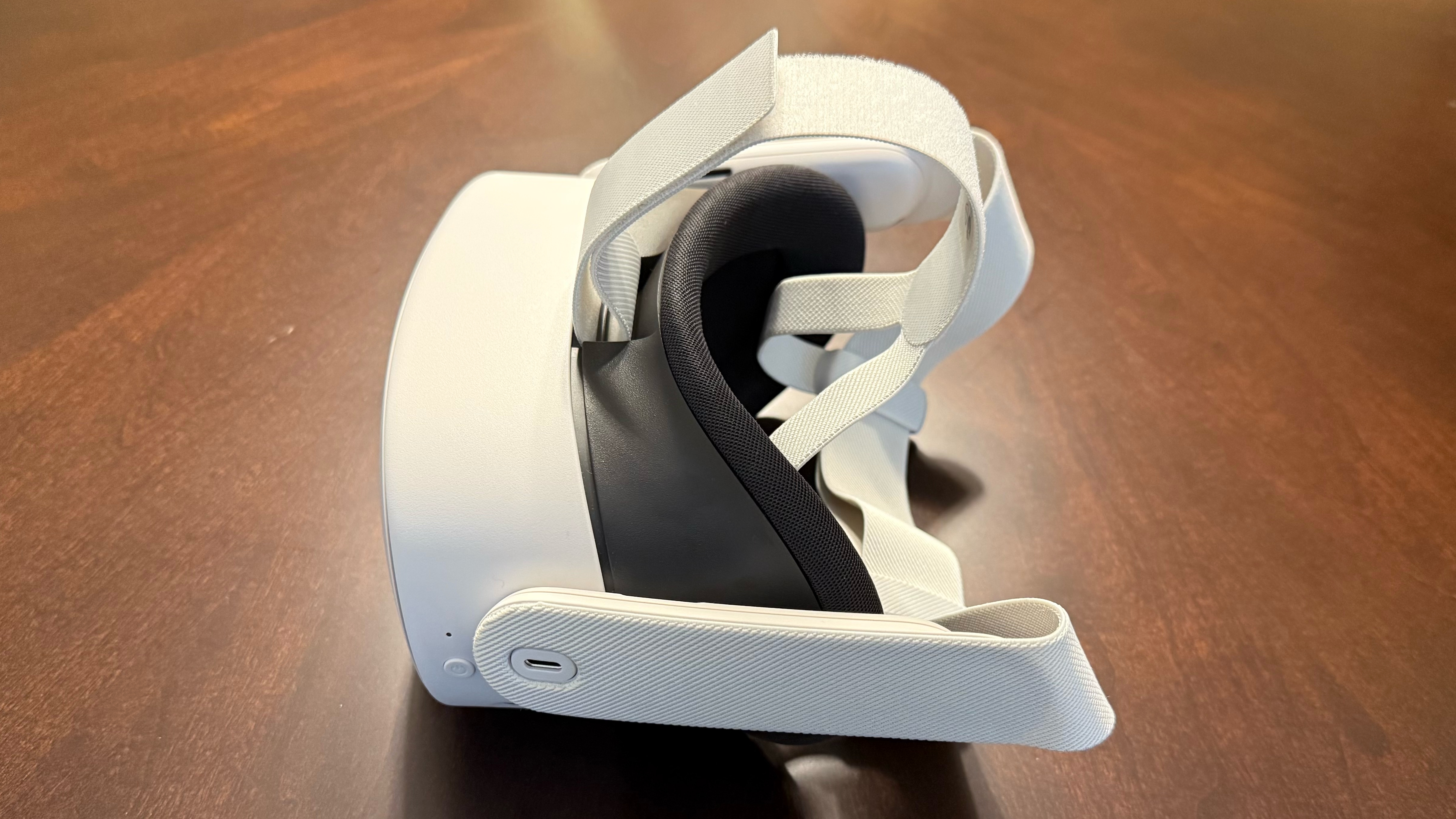
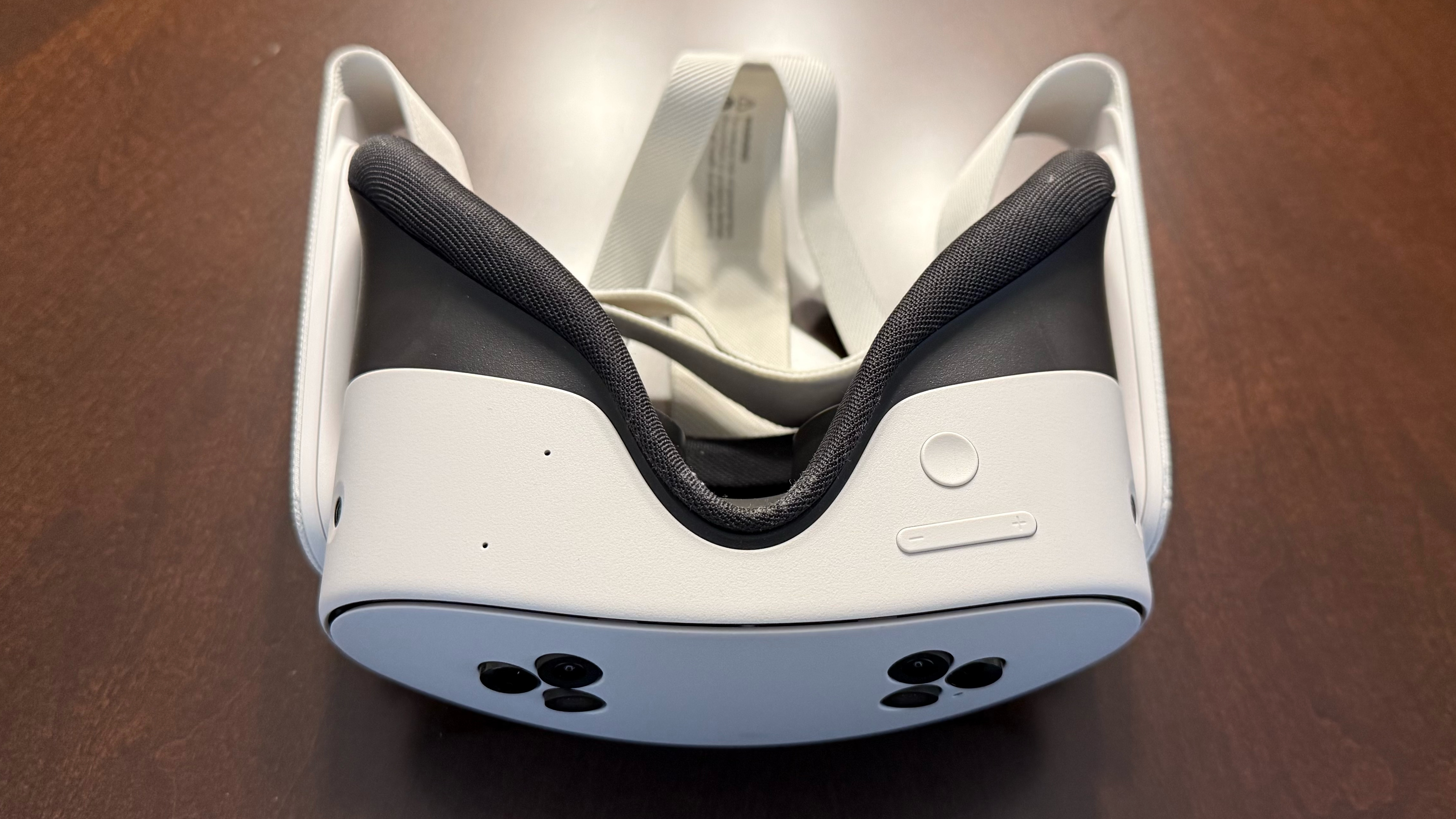
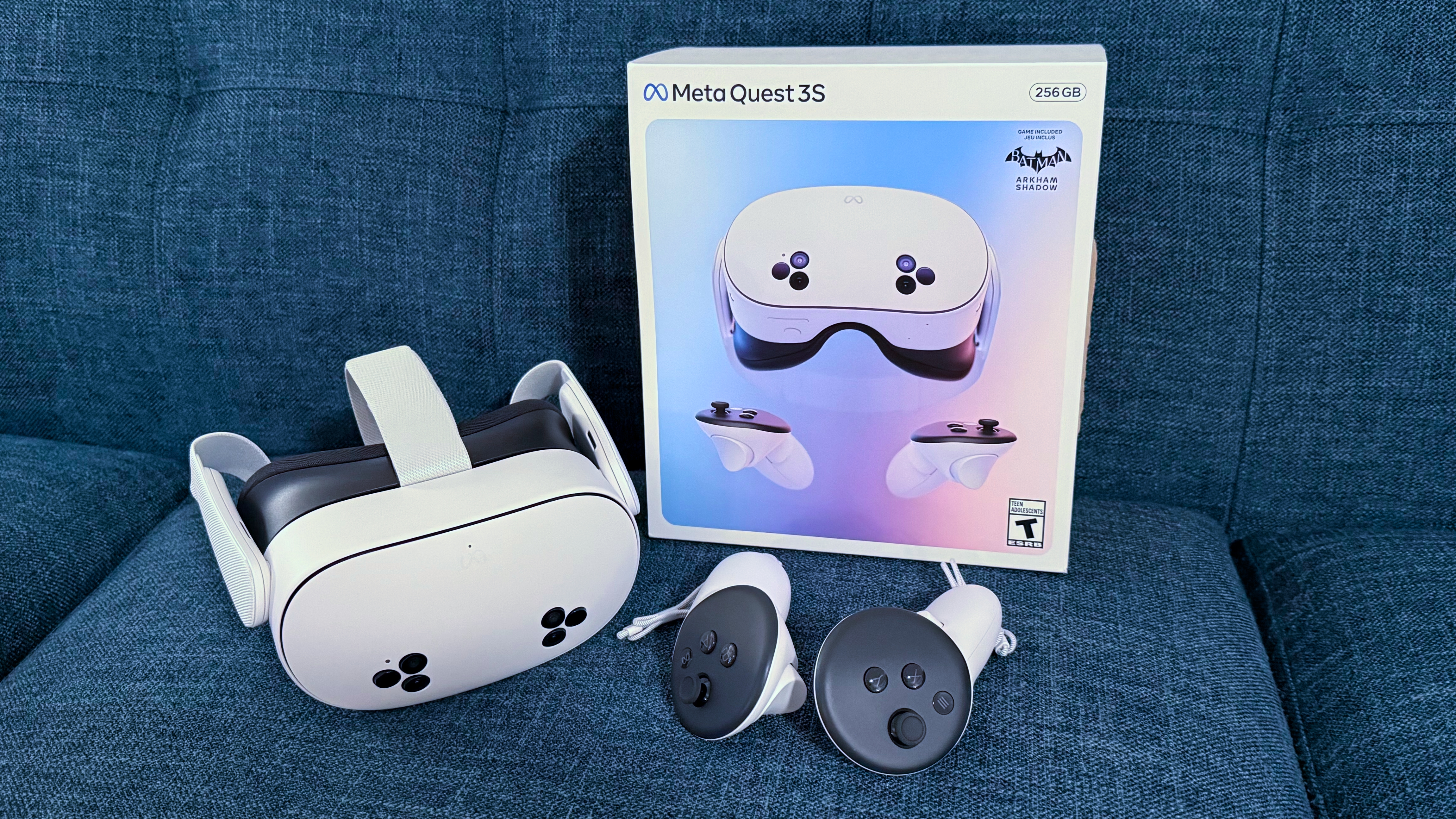
The headset uses the "Y" style head strap that came with the Quest 3. To get the proper fit, I placed the headset on my head and pulled the two straps outward. This provided a relatively tight fit for my face. However, since the bridge of my nose is relatively short and broad, the Quest 3 would slide slightly downward the longer I wore it, requiring me to retighten the straps for a proper fit.
The box includes a USB-C charging brick, a 1-meter USB-C to USB-C charging cable, and a plastic spacer to provide additional clearance for people who wear prescription glasses with the Quest 3S.
As for the controllers, they are identical to the set that came with the Quest 3. In other words, they’re constructed of the same white plastic found on the headset. It would be nice if they were offered in colors other than white, as white tends to get a bit grimy over time from sweat with regular use. Each controller has a thumbstick, two face-mounted buttons (X and Y on the left controller, A and B on the right controller), a grip button, and a trigger button.
Get Tom's Hardware's best news and in-depth reviews, straight to your inbox.
The left controller has an additional Menu button on its face, while the right controller has an extra Meta button. One AA battery (alkaline AA batteries are already inserted from the factory) powers each controller. However, we’d recommend getting at least two sets of rechargeable lithium-ion AA batteries so that you can always have a fresh set ready to swap out when the low battery warning appears.
Meta Quest 3S Specifications
| Display | 1832 x 1920 per eye (773 ppi) |
| Display Type | LCD |
| Refresh Rate | 72 Hz, 90 Hz, 120 Hz |
| Processor | Qualcomm Snapdragon XR2 Gen 2 |
| RAM | 8GB |
| Storage | 128GB or 256GB |
| Field of View | 96 degrees horizontal, 90 degrees vertical |
| Degrees of Freedom | 6 DoF |
| Audio | Dual open-air speakers |
| Wireless Connectivity | Wi-Fi 6E, Bluetooth 5.2 |
| Battery Life | 4324 mAh (up to 2.5 hours) |
| Weight | 1.13 pounds (514 grams) |
Meta Quest 3S Hardware
Another change compared to the Quest 3 comes with the type of lenses used on the headset. The Quest 3 uses pancake lenses that offer a more comprehensive degree of adjustability for your field of vision. The Quest 3S, on the other hand, employs Fresnel lenses with just three fixed adjustment settings. As a result, there is a narrower field of view and less of a range of configurability. This tradeoff had to be made to hit a lower price point. For reference, the interpupillary distance (IPD) range of the Quest 3 is 53 to 75 mm, while the Quest 3S’ range is narrower at 58 to 68 mm. My IPD is 71 mm, so I initially had some trouble with my eyes focusing properly with the dual displays of the Quest 3S.
Another step backward on the spec sheet comes with the two LCDs, one for each eye. On the Quest 3, each display provided a resolution of 2064 x 2208 per eye while operating at up to 120 Hz. You still get up to a 120 Hz refresh rate with the Quest 3S, but the resolution drops to 1832 x 1920 per eye. To put that in perspective, the Quest 3 displays give you 1,218 pixels per inch (ppi), while the Quest 3S delivers 773 ppi. The “screen door” effect is definitely more noticeable on the Quest 3S, particularly when using the passthrough mode.
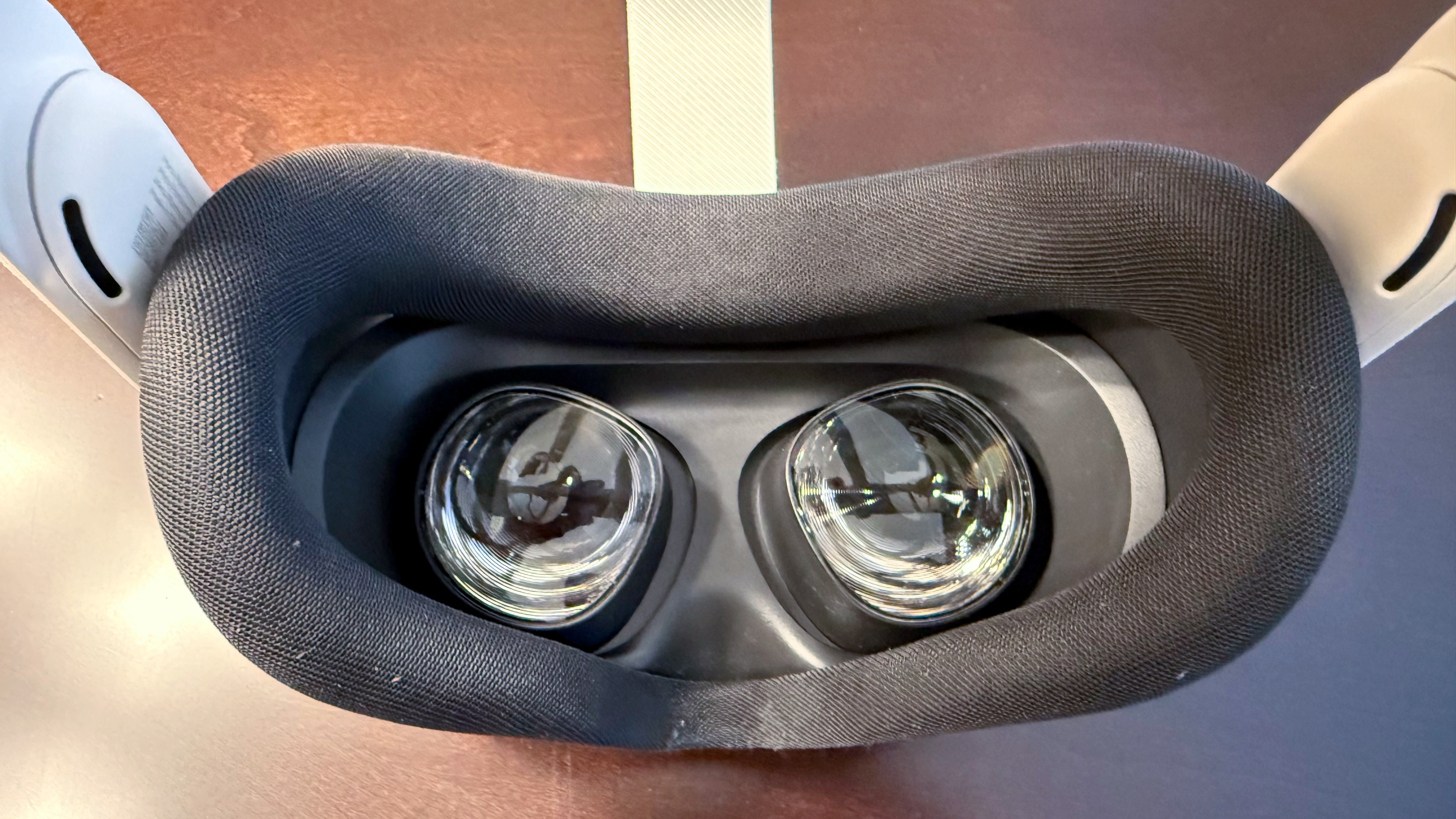
Luckily, performance hasn't taken a backseat to its more expensive sibling. The Quest 3S still uses a Qualcomm Snapdragon XR2 Gen 2 SoC with 8GB of RAM. You also get 128GB or 256GB storage configurations, although our review unit was the 256GB version (the Quest 3 is available in 128GB or 512GB SKUs). Like the Quest 3, the Quest 3S supports Wi-Fi 6E, allowing the headset to operate on the higher-performance 6 GHz wireless band.
On the sound front, the Quest 3S features a pair of speakers mounted in each arm. They provide decent audio and are the lowest-impact way of enjoying audio with the headset. However, you can also connect Bluetooth headphones to the Quest 3S or use a USB-C to 3.5mm adapter to connect wired headphones.
The Quest 3S has a smaller battery (4324 mAh) compared to the Quest 3 (5060 mAh) but a longer runtime (2.5 hours versus 2.2 hours). While the Quest 3S is technically lighter than the Quest 3 (514 grams versus 515 grams), it’s not a difference that is noticeable to mere mortals.
Using the Meta Quest 3S
The setup process for the Quest 3S was relatively straightforward and similar to what I experienced setting up the Quest 3 last year. I placed the Quest 3S on my head, adjusted the straps, and manually pushed the lenses out to their maximum spacing (out of three fixed settings). The setup program required me to log on to my wireless network, and since I already had the Meta Quest app on my phone, it automatically linked the new headset to my Facebook account.
The setup program next performed a firmware update on the headset, which took about five minutes to complete. After that step, the setup process was complete. Each new Meta Quest 3S includes a copy of Batman: Arkham Shadow for free, so that was the first thing I downloaded to the headset (it was a relatively large 19GB download).
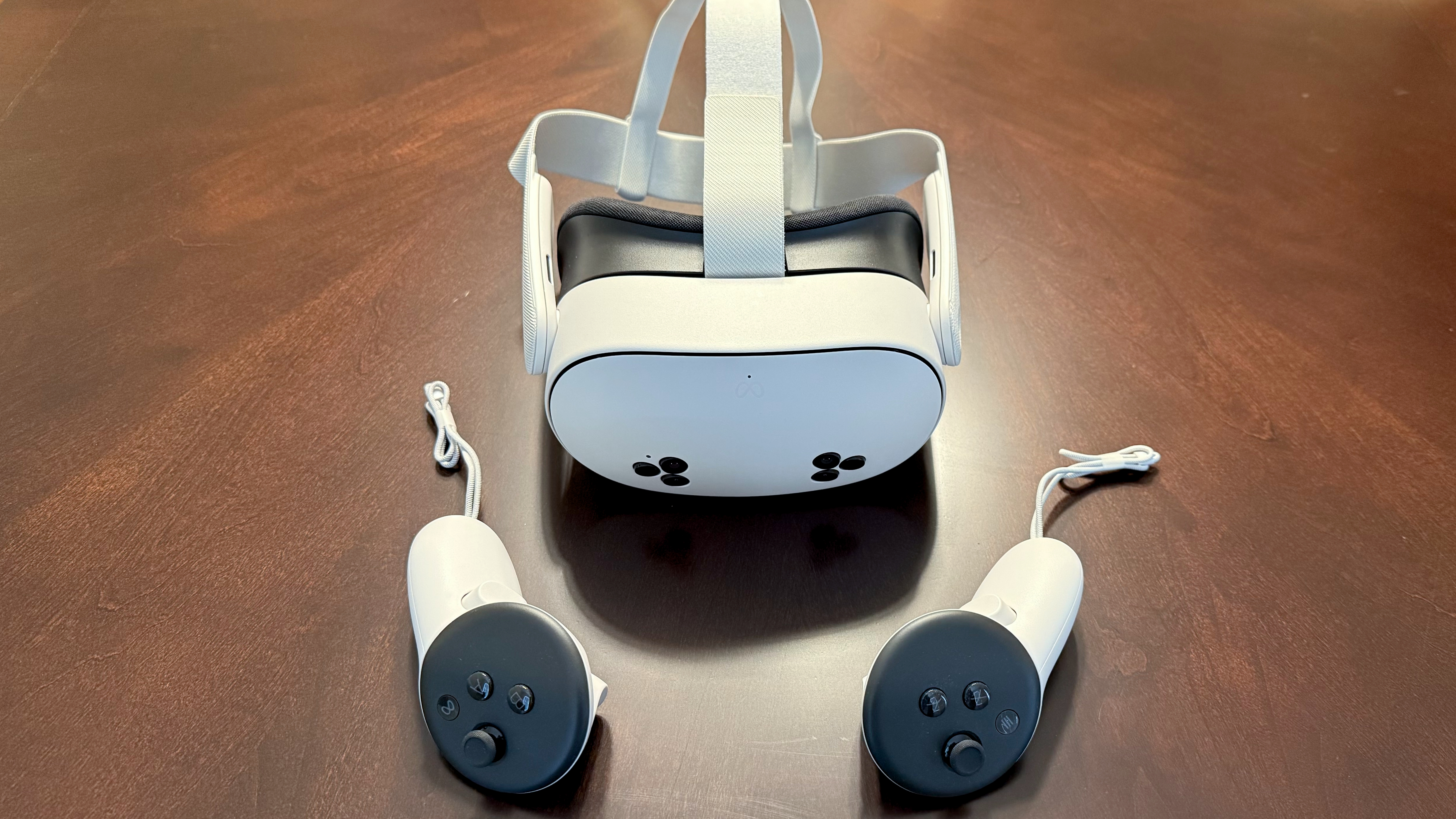
I spent a lot of time playing Arkham Shadow, even though it initially gave me bouts of motion sickness. VR games don’t typically make me nauseous, but looking over ledges and climbing up and down ladders made me feel slightly queasy in Arkham Shadow. However, given how engaging the gameplay was, my brain eventually realized that I wouldn’t fall to my ultimate doom while playing the game.
After years of playing Batman games by staring at a big screen TV and mashing buttons, it was an absolute joy to have a slightly different and much more immersive experience by wailing on enemies using my fists (just make sure that your family members aren’t anywhere near you if you go into full-on “Batfleck” mode).
Playing the game gave me a real visual taste of the difference between the Quest 3 and Quest 3S back-to-back. The sharper resolution of the Quest 3 was immediately noticeable to me in Arkham Shadow compared to the Quest 3S. Everything in-game looked sharper and more refined, as expected, with the crisper displays and tighter focus controls.
The lower resolution experience extended to every aspect of using the Quest 3S, including the main Horizon OS interface. Everything looks a touch fuzzier and grainier on the Quest 3S, given the hardware compromises required to trim $200 from the price.
The Quest 3S still supports full-color passthrough mode, but it is now accessible by pressing the action button mounted on the bottom of the headset near the volume controls. Pressing the action button cycles between passthrough and immersive modes. Although the onboard cameras can’t replicate the reality around you in the same clarity as your eyes in passthrough mode, it is good enough. I could walk around the house with the headset on and **gasp** up and down stairs. I could even use my smartphone while wearing the Quest 3S, although I had to squint a little sometimes and briefly remove the headset when using Face ID to authenticate certain apps. I could also read text on my desktop monitor (5120 x 1440 resolution), even if the words were a bit blurry.
While I noticed the visual differences, it likely wouldn’t be an issue for a newcomer who has never laid hands (or eyes) on the older Quest 3. If you have your eyes on the Quest 3S, my advice would be not to try the Quest 3, or you will forever have the fear of missing out.
Bottom Line
The Quest 3S is the next logical step in Meta’s evolution of mixed-reality headsets. The Meta Quest 3 had impressive hardware, but the library of apps and games that made use of the platform was a bit lacking. A year after the Quest 3’s launch, the Quest 3S arrives with the same computing hardware and a much lower price tag. A $200 discount is nothing to sneeze at when discussing a niche device like a mixed-reality headset.
The main tradeoff for the lower price tag is the lower resolution displays, narrower IPD adjustment range, and shallower field of view. For people who haven’t already experienced the Quest 3, these downsides aren’t likely to be significant detractors from purchasing the headset.
Ultimately, you get a high-quality headset with comfortable wireless controllers, excellent overall performance for gaming, and an attractive price tag. At the time of this writing, you can purchase the Quest 3S 128GB for $299 and receive a $75 digital credit at Amazon. And don’t forget that you also get the excellent Batman: Arkham Shadow included with your purchase, which should provide hours of enjoyment. Sure, it’s no Quest 3, but there’s a lot to love at this price.

Brandon Hill is a senior editor at Tom's Hardware. He has written about PC and Mac tech since the late 1990s with bylines at AnandTech, DailyTech, and Hot Hardware. When he is not consuming copious amounts of tech news, he can be found enjoying the NC mountains or the beach with his wife and two sons.
-
-Fran- Thanks a lot for this review and impressions.Reply
It's really hard to get reviews of the few VR headsets as it is, so I really appreciated having one for the cheaper sibling of the MQ3.
Did you give it a try in PC mode? How was the controllers latency and field of response? Would you play BeatSaber in both PC mode and Quest mode? :D
Man... A revisit of the Index would be fantastic as well. Specially with all the software changes Valve has introduced.
Regards. -
Geef Great review man.Reply
One thing you might want to modify if possible is on the specs table do a listing for the 3 and the 3S. Also lower it down on your review so people don't immediately just scroll past just to look at it. :sneaky:
